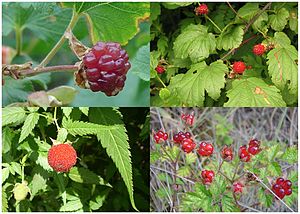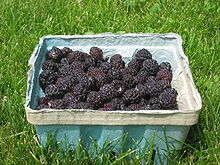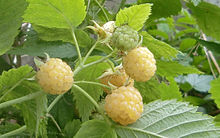- Raspberry
-
This article is about the various species of raspberry in the plant genus Rubus. For the widely cultivated Eurasian red raspberry, see Rubus idaeus. For the North American black raspberry, see Rubus occidentalis. For other uses, see Raspberry (disambiguation).
The raspberry or hindberry is the edible fruit of a multitude of plant species in the genus Rubus, most of which are in the subgenus Idaeobatus; the name also applies to these plants themselves. Raspberries are perennial, with woody stems.
Contents
Species
 Fruit of four species of raspberry. Clockwise from top left: Boulder raspberry, Korean raspberry, Australian native raspberry, West Indian raspberry
Fruit of four species of raspberry. Clockwise from top left: Boulder raspberry, Korean raspberry, Australian native raspberry, West Indian raspberry
Examples of raspberry species in Rubus subgenus Idaeobatus include:
- Rubus crataegifolius (Korean raspberry)
- Rubus gunnianus (Tasmanian alpine raspberry)
- Rubus idaeus (European red raspberry)
- Rubus leucodermis (Whitebark or Western raspberry, Blue raspberry, Black raspberry)
- Rubus occidentalis (Black raspberry)
- Rubus parvifolius (Australian native raspberry)
- Rubus phoenicolasius (Wine raspberry or Wineberry)
- Rubus rosifolius (West Indian raspberry)
- Rubus strigosus (American red raspberry) (syn. R. idaeus var. strigosus)
- Rubus ellipticus (Yellow Himalayan Raspberry)
Several species of Rubus are also called raspberries that are classified in other subgenera, including:
- Rubus arcticus (Arctic raspberry, subgenus Cyclactis)
- Rubus deliciosus (Boulder raspberry, subgenus Anoplobatus)
- Rubus nivalis (Snow raspberry, subgenus Chamaebatus)
- Rubus odoratus (Flowering raspberry, subgenus Anoplobatus)
- Rubus sieboldii (Molucca raspberry, subgenus Malachobatus)
Major kinds of cultivated raspberries
 Fruit of red raspberry (Rubus idaeus) in the Czech Republic
Fruit of red raspberry (Rubus idaeus) in the Czech Republic
Raspberries are an important commercial fruit crop, widely grown in all temperate regions of the world.
Many of the most important modern commercial red raspberry cultivars derive from hybrids between R. idaeus and R. strigosus.[1] Some botanists consider the Eurasian and American red raspberries to all belong to a single, circumboreal species, Rubus idaeus, with the European plants then classified as either R. idaeus subsp. idaeus or R. idaeus var. idaeus, and the native North American red raspberries classified as either R. idaeus subsp. strigosus, or R. idaeus var. strigosus. Recent breeding has resulted in cultivars that are thornless and more strongly upright, not needing staking.
The black raspberry, Rubus occidentalis, is also occasionally cultivated in the United States, providing both fresh and frozen fruit as well as jams, preserves, and other products, all with that species' distinctive, richer flavour.
Purple raspberries have been produced by horticultural hybridization of red and black raspberries, and have also been found in the wild in a few places (for example, in Vermont) where the American red and the black raspberries both grow naturally. The botanical name Rubus × neglectus applies to these naturally occurring plants as well as horticulturally produced plants having the same parentage. Commercial production of purple-fruited raspberries is rare.
Both the red and the black raspberry species have albino-like pale-yellow natural or horticultural variants resulting from presence of recessive genes that impede production of anthocyanin pigments.[citation needed] Fruits from such plants are called golden raspberries or yellow raspberries; despite their similar appearance, they retain the distinctive flavour of their respective species (red or black). Most pale-fruited raspberries commercially sold in the eastern United States are derivatives of red raspberries. Yellow-fruited variants of the black raspberry are sometimes grown in home gardens.
Red raspberries have also been crossed with various species in other subgenera of the genus Rubus, resulting in a number of hybrids, the first of which was the loganberry. Later notable hybrids include boysenberry (a multi-generation hybrid), and Tayberry. Hybridization between the familiar cultivated red raspberries and a few Asiatic species of Rubus has also been achieved.
Uses
Fruits
Raspberries are grown for the fresh fruit market and for commercial processing into individually quick frozen (IQF) fruit, purée, juice, or as dried fruit used in a variety of grocery products. Traditionally, raspberries were a mid-summer crop, but with new technology, cultivars, and transportation, they can now be obtained year-round. Raspberries need ample sun and water for optimal development. Raspberries thrive in well-drained soil with a pH of between 6 and 7 with ample organic matter to assist in retaining water.[2] While moisture is essential, wet and heavy soils or excess irrigation can bring on Phytophthora root rot which is one of the most serious pest problems facing red raspberry. As a cultivated plant in moist temperate regions, it is easy to grow and has a tendency to spread unless pruned. Escaped raspberries frequently appear as garden weeds, spread by seeds found in bird droppings.
An individual raspberry weighs about 4 g, on average[3] and is made up of around 100 drupelets,[4] each of which consists of a juicy pulp and a single central seed. Raspberry bushes can yield several hundred berries a year. Unlike blackberries and dewberries, a raspberry has a hollow core once it is removed from the receptacle.
Raspberry nutrients and health benefits
Raw Raspberries Nutritional value per 100 g (3.5 oz) Energy 263.592 kJ (63.000 kcal) Carbohydrates 14.7 g - Sugars 5.4 g - Dietary fibre 8 g Fat .8 g - saturated 0 g - monounsaturated .1 g - polyunsaturated .5 g Protein 1.5 g Vitamin A equiv. 1 μg (0%) - beta-carotene 120 μg (1%) Vitamin C 26.2 mg (32%) Calcium 25 mg (3%) Iron .69 mg (5%) Sodium 1 mg (0%) Percentages are relative to US recommendations for adults.
Source: USDA Nutrient DatabaseRaspberries contain significant amounts of polyphenol antioxidants such as anthocyanin pigments linked to potential health protection against several human diseases.[5] The aggregate fruit structure contributes to its nutritional value, as it increases the proportion of dietary fibre, placing it among plant foods with the highest fibre contents known, up to 20% fibre per total weight. Raspberries are a rich source of vitamin C, with 30 mg per serving of 1 cup (about 50% daily value), manganese (about 60% daily value) and dietary fibre (30% daily value). Contents of B vitamins 1-3, folic acid, magnesium, copper and iron are considerable in raspberries.[6]
Raspberries rank near the top of all fruits for antioxidant strength, particularly due to their dense contents of ellagic acid (from ellagotannins, see for instance raspberry ellagitannin), quercetin, gallic acid, anthocyanins, cyanidins, pelargonidins, catechins, kaempferol and salicylic acid. Yellow raspberries and others with pale-coloured fruits are lower in anthocyanins.
Due to their rich contents of antioxidant vitamin C and the polyphenols mentioned above, raspberries have an ORAC value (oxygen radical absorbance capacity) of about 4900 per 100 grams, including them among the top-ranked ORAC fruits. Cranberries and wild blueberries have around 9000 ORAC units and apples average 2800.[7]
Although there are no clinical studies to date proving these effects in humans, antioxidant and antiproliferative (chemopreventive) effects against cancer have been linked to the amount of phenolics and flavonoids in various foods including raspberries.[8][9][10]
Raspberries are a low-glycemic index food, as are most other berries.
Commercial production
Output in Tons, 2003-2004:
FAOSTAT (FAO) Russia
Russia95000 26 % 110000 28 %  Serbia
Serbia79471 21 % 79180 20 %  United States
United States48535 13 % 50000 13 %  Poland
Poland42941 12 % 42000 11 %  Germany
Germany20600 6 % 20500 5 %  Ukraine
Ukraine19700 5 % 20000 5 %  Canada
Canada14236 4 % 13700 4 %  Hungary
Hungary9000 2 % 10000 3 %  United Kingdom
United Kingdom8000 2 % 8000 2 %  France
France6830 2 % 7500 2 % The Rest 27603 7 % 27890 7 % Total 371916 100 % 389061 100 % See table and map at right
Leaves
Raspberry leaves can be used fresh or dried in herbal and medicinal teas. They have an astringent flavour, and in herbal medicine are reputed to be effective in regulating menses.
Cultivation
Raspberries are traditionally planted in the winter as dormant canes, although planting of tender, plug plants produced by tissue culture has become much more common. A specialized production system called "long cane production" involves growing canes for 1 year in a northern climate such as Scotland (UK) or Washington State (US) where the chilling requirement for proper bud break is met early. These canes are then dug, roots and all, to be replanted in warmer climates such as Spain where they quickly flower and produce a very early season crop. Plants should be spaced 1 m apart in fertile, well drained soil; raspberries are usually planted in raised beds/ridges if there is any question about root rot problems.
The flowers can be a major nectar source for honeybees and other pollinators.
Raspberries are very vigorous and can be locally invasive. They propagate using basal shoots (also known as suckers); extended underground shoots that develop roots and individual plants. They can sucker new canes some distance from the main plant. For this reason, raspberries spread well, and can take over gardens if left unchecked.
The fruit is harvested when it comes off the torus/receptacle easily and has turned a deep colour (red, black, purple, or golden yellow, depending on the species and cultivar). This is when the fruits are ripest and sweetest. Excess fruit can be made into raspberry jam or frozen.
Selected important cultivars
Numerous raspberry cultivars have been selected. Raspberries are often propagated using cuttings and will root readily in moist soil conditions. Using cuttings preserves the genotype of the parent, and is the preferred method of propagation when making large plantings[citation needed].
Two types of most commercially grown kinds of raspberry are available, the summer-bearing type that produces an abundance of fruit on second-year canes (floricanes) within a relatively short period in mid-summer, and double- or "ever"-bearing plants, which also bear some fruit on first-year canes (primocanes) in the late summer and fall, as well as the summer crop on second-year canes. Various kinds of raspberries can be cultivated from hardiness zones 3 to 9.
Source: New RHS Dictionary of Gardening.[1]
- Red, early summer fruiting
- Boyne
- Fertődi Venus
- Rubin Bulgarski
- Cascade Dawn
- Glen Clova
- Glen Moy
- Killarney
- Malahat
- Malling Exploit
- Titan
- Willamette
- Red, mid summer
- Cuthbert
- Lloyd George
- Meeker
- Newburgh
- Ripley
- Skeena
- Cowichan
- Chemainus
- Saanich
- Red, late summer
- Cascade Delight
- Coho
- Fertődi Rubina
- Glen Prosen
- Malling Leo
- Octavia
- Schoenemann
- Tulameen
- Red, primocane, fall, autumn fruiting
- Amity
- Augusta
- Autumn Bliss
- Joan J (Thornless)
- Caroline
- Fertődi Kétszertermő
- Heritage
- Josephine
- Ripley
- Summit
- Zeva Herbsternte
- Gold/Yellow, primocane, fall, autumn fruiting
- Anne
- Fallgold
- Fertődi Aranyfürt
- Goldenwest
- Golden Queen
- Honey Queen
- Kiwi Gold
- Purple
- Brandywine
- Royalty
- Black
- Black Hawk
- Bristol
- Cumberland
- Glencoe
- Jewel
- Munger
- Ohio Everbearer
- Scepter
Diseases and pests
Raspberries are sometimes eaten by the larvae of some Lepidoptera species (butterflies and moths). See list of Lepidoptera that feed on Rubus.
Botrytis cinerea, or Gray Mould, is a common fungal infection of raspberries and other soft fruit. It is seen as a grey mould growing on the raspberries, and particularly affects fruit which is bruised, as it provides an easy entrance point for the spores of B. Cinerea.
Raspberry plants should not be planted where potatoes, tomatoes, peppers, eggplants or bulbs have previously been grown, without prior fumigation of the soil. These crops are hosts for the disease Verticillium Wilt, a fungus that can stay in the soil for many years and can infest the raspberry crop.[11]
See also
- Red raspberry leaf, used as a herb
- Chambord Liqueur Royale de France
- List of culinary fruits
- Raspberry ketone
References
- ^ a b Huxley, A., ed. (1992). New RHS Dictionary of Gardening. Macmillan ISBN 0-333-47494-5.
- ^ Strick, B.C.. "Growing Raspberries in Your Home Garden". Growing Small Fruits. Oregon State University Extension Service. http://www.weeksberry.com/berryfiles/files/Raspberry.pdf. Retrieved 18 August 2011.
- ^ Health and healing fact sheets, blackberries ~ Connecting Berry Health Benefit Researchers
- ^ Iannetta, P. P. M.; Wyman, M.; Neelam, A.; Jones, C.; Taylor, M. A.; Davies, H. V.; Sexton, R. (December 2000). "A causal role for ethylene and endo-beta-1,4-glucanase in the abscission of red-raspberry (Rubus idaeus) drupelets". Physiol Plant 110 (4): 535–543. doi:10.1111/j.1399-3054.2000.1100417.x. http://www.blackwell-synergy.com/doi/abs/10.1111/j.1399-3054.2000.1100417.x.
- ^ Journal of Agricultural and Food Chemistry Presents Research from the 2007 International Berry Health Benefits Symposium, Journal of Agricultural and Food Chemistry ACS Publications, February 2008
- ^ World's Healthiest Foods, in-depth nutrient profile for raspberries
- ^ Wu X, Beecher GR, Holden JM, Haytowitz DB, Gebhardt SE, Prior RL (June 2004). "Lipophilic and hydrophilic antioxidant capacities of common foods in the United States". J. Agric. Food Chem. 52 (12): 4026–37. doi:10.1021/jf049696w. PMID 15186133.
- ^ Liu M, Li XQ, Weber C, Lee CY, Brown J, Liu RH (May 2002). "Antioxidant and antiproliferative activities of raspberries". J. Agric. Food Chem. 50 (10): 2926–30. doi:10.1021/jf0111209. PMID 11982421.
- ^ Heinonen M (June 2007). "Antioxidant activity and antimicrobial effect of berry phenolics—a Finnish perspective". Mol Nutr Food Res 51 (6): 684–91. doi:10.1002/mnfr.200700006. PMID 17492800.
- ^ Cerdá B, Tomás-Barberán FA, Espín JC (January 2005). "Metabolism of antioxidant and chemopreventive ellagitannins from strawberries, raspberries, walnuts, and oak-aged wine in humans: identification of biomarkers and individual variability". J. Agric. Food Chem. 53 (2): 227–35. doi:10.1021/jf049144d. PMID 15656654.
- ^ Spooner farms certified raspberry Plants "Planting Information" http://www.spoonerfarms.com/plantinginformation.htm
Categories:- Rubus
- Berries
- Plant common names
Wikimedia Foundation. 2010.





